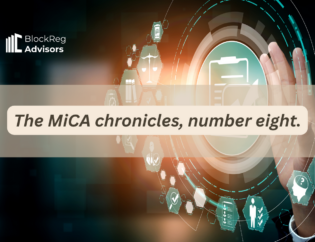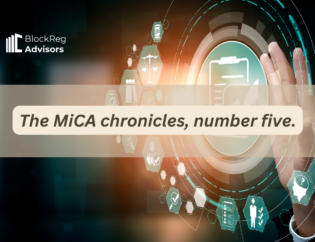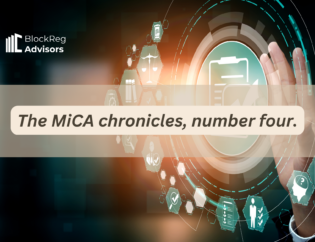
By
Martinho Pires
Senior Consultant
Representation, reference, and redemption: considering the definitions of e-money tokens and asset-reference tokens in MiCA
Crypto assets are mediums, or, in other words, forms or even formats for representing, digitally, any kind of value. The essence of their functionality is representation: something that depicts an existing reality or serves as a form for exercising a right over that same reality.
Stablecoins, according to market parlance, are a type of crypto assets that purport to represent the value of an existing currency or asset. They are one of the most important items in crypto markets, functioning as a practical means of exchange between users: a “tokenized” form of payment that facilitates the movement of a pre-established value without the risks of volatility that other tokens (such as Bitcoin, or Ether) have. Additionally, they can serve as store of value, in digital format.
To guarantee that the value of the stablecoin token remains, as the name suggests, “stable”, it is necessary for stablecoins’ issuers to have the capacity of answering potential requests of redemption from holders of said tokens. If there is not enough collateral to support the peg of the stablecoin to the represented value, then the representation is nothing but a fiction, and the stablecoin is worthless, which will have dramatic effects in the market. The Terra Luna crash is a case in point.
Therefore, stablecoin issuers are required to have liquid reserves in place as collateral. The more collateralized a stablecoin is, the bigger the capacity for redemption, and the better it keeps the value of the token pegged to the desired currency value. Consequently, a strongly backed stablecoin poses less risks to the market.
The composition of reserves backing stablecoins is diverse. Some issuers hold reserves in cash, or in a mixture of cash and cash-like instruments (such as treasury bills), like Tether or Circle; other issuers hold reserves in a mixture of different currencies (“baskets” of currencies) or assets (such as the failed Libra / Diem project), or through mechanisms established by algorithms (algorithmic stablecoins), such as Frax, EURangle, and others. Despite the diversity of compositions, the objective of all reserves or reserve mechanisms is to stabilize the peg of the stablecoin to the desired value.
Regulatory developments concerning crypto assets also considered stablecoins and the impact they might have on the payment sector and on the transmission of monetary policy. The Market in Crypto-Assets Regulation (MiCA) was no exception. MiCA establishes rules for the issuing of stablecoins as well as obligations that stablecoin issuers must follow before, during and after the issuance. However, the EU decided to take an innovative approach and regulate stablecoins under two normative figures: one is e-money tokens (EMTs) and the other is asset-reference tokens (ARTs). An EMT, for MiCA, is a “type of crypto-asset that purports to maintain a stable value by referencing the value of one official currency”, while an ART is a “type of crypto-asset that is not an electronic money token and that purports to maintain a stable value by referencing another value or right or a combination thereof, including one or more official currencies” (1).
Such approach differs from other regulatory initiatives taken globally; for example, stablecoin regulation issued by the Monetary Authority of Singapore only covers “single currency stablecoins pegged to the Singapore dollar or Group of Ten (G10) currencies, that are issued in Singapore” (2), while other types of stablecoins are regulated under local payment rules. Another example is the Virtual Asset Regulatory Authority of Dubai, whose rules seem to explicitly acknowledge as stablecoins only those tokens that reference US dollars or Arab Emirates Dirham (3).
Therefore, in the EU, stablecoin issuers shall need to declare if their token is an EMT or an ART. The answer to the question has important consequences since there are significant differences in the applicable legal regimes. An EMT is considered by MiCA as “electronic money”, and it can only by issued by electronic money institutions (EMIs) (4), which means that the electronic money regime shall apply to an extent to the issuers of EMTs (5). On the other hand, if the token is an ART, the issuer does not need to be previously registered as a regulated institution (although if it is a credit institution, specific rules apply (6)), but requires an authorization by a national competent authority (NCA) to issue the token. Furthermore, the authorization requires the issuer to comply with certain obligations, before, during and after the issuing of the token. Such obligations concern, for example, having adequate governance and risk management structures in place, have certain capital requirements, reserves of assets, and comply with information duties (7).
Qualification of a token as falling under one or the other normative definition is not only important for knowing the applicable legal regime, but also to launch the token in the first place. According to MiCA, issuers of ARTs must, when requesting authorization for the issuance, submit a legal opinion to the NCA stating why the ART cannot be qualified as a token excluded from the scope of the regulation nor as an EMT (8). This is an intriguing requirement – and shall be subject to a future chapter in these chronicles – that shows the importance of understanding the legal concepts in place and how they can shape the regulatory terms in place.
Let us then look at the concepts in more detail. Both types of crypto-assets have the objective of maintaining a stable value, and both do it by reference to another (external) value. These are the similarities. The differences are that the reference of an EMT is only to the value of one official currency, while the reference of an ART can be to a value other than an official currency, or a reference to the value of a mix of a currency and another value(s), or to the value of two or more currencies. Referencing a combination of values, rights, or currencies is to reference the combined value of those assets.
What is the normative meaning of “maintaining a stable value”? The assets referred to by EMTs or ARTs may see their value fluctuate in specific markets (think about currency fluctuations in foreign exchange markets), so the idea of a stable value cannot mean that the value of the EMT or the ART is always stable: just that it represents (or attempts to represent) to the value of another reality that is external to the token.
What about the meaning of the expression “making reference to”? I sometimes find it a bit confusing, and I think its meaning should be seen in light of the topic of representation and redemption discussed in the beginning of this note. Call it, if you want, the “triple-R” logic of stablecoins: the token referring a value means that the token has the purpose of representing (in a digital form) such value, thus generating a legitimate expectation on the token holder of redeeming the token at par value. Following this triple-R logic, we can then see how the two concepts of EMT and ART are, in essence, functionally similar, albeit different in structure: EMT refers to the value of one single currency, while ARTs refer to values other than currencies, or to a value composed of more than the value of one currency.
Why, then, if there is sufficient similarity between the two realities, did the EU legislator choose to establish two different concepts, and not just a general one (like “stablecoins”)? According to MiCA, certain stablecoins are functionally like e-money, while other are not. For the EU, e-money is “electronically, including magnetically, stored monetary value as represented by a claim on the issuer which is issued on receipt of funds for the purpose of making payment transactions as defined in point 5 of Article 4 of Directive 2007/64/EC, and which is accepted by a natural or legal person other than the electronic money issuer” (9). Stablecoins that purport to represent the value of one single currency are, “like electronic money (…) [a form of] electronic surrogates for coins and banknotes and are likely to be used for making payments” (10). Given that the use of EMTs might pose risks for financial stability and the transmission of monetary policy due to their use as payment systems, in the same way as e-money can, it made sense to put them under the regulatory and supervisory structures dedicated to protecting the stability of the financial system through e-money rules.
ARTs – that is, tokens that represent a value referenced to assets other than currencies or to a combination of different assets – offer different challenges than EMTs. Their subsumption (in abstract) within the definition of e-money would be complex, to say the least (they are not necessarily “stored monetary value”, they are not necessarily “issued in the receipt of funds”, and they are not necessarily used a payment instrument). It is possible to think of ARTs that do not fall under such requirements, such as a token that refers to the value of a commodity, like gold or oil. However, there are other forms of tokens that are considered by some (11) as ARTs (Libra / Diem, for example, or DAI) that serve, functionally, as payment instruments, are stored monetary value (if supported by a basket of currencies) and can, at least in abstract, be issued in the receipt of funds. The difference is that they refer to the value of a combination of currencies, or to other forms of value, even if the 1:1 value they wish to maintain stable with (for example, the US dollar) is not part of that reference.
The EU legislator decided to put them all in the same normative bag, because of the common element that is the reference value, and the stability mechanism in place. If the reference value is one official currency, it is easier to put such stablecoins under the e-money wing. If it is more complex than just one currency, then a new regime – although with similarities with e-money rules, in terms of redemption (12) - applies. The difference boils down, to the structure of the stability mechanism.
The problem here is that, as discussed two paragraphs above, there are tokens which might be structurally ARTs, but that can be, materially, EMTs. DAI and other stablecoins that are backed by values other than one official currency have some material similarities with the definition of e-money. To add some more complexity in the mix, let us go back to the definition of an ART in MICA, that states that an ART is a crypto-asset that is not an electronic money token. This consideration seems, at first glance, superfluous: according to the definition, an ART refers to values other than one official currency, which makes it different than an EMT. Why add on top of that, and right in the beginning of the definition, that an ART to be an ART under MiCA cannot be EMT?
One possible explanation for making sense of this definition is to consider that an ART cannot be, materially speaking, an EMT. That is: it should not be e-money, also functionally. In this sense, an ART should not be “monetary value as represented by a claim on the issuer which is issued on receipt of funds” and that is accepted generally as a means of payment. If this is the reading of the provision, then in MiCA a stablecoin is to be an EMT, and a means of payment; ARTs should only be stores of value, but not used as payment. This reading, of course, would make it very difficult for certain stablecoins such as DAI to be considered ART, while due to their backing system it would be challenging to consider them as EMT. A normative gap emerges.
The more practical solution would be to ignore the reference to it is not an electronic money token and the payment character and just consider the referral structure as the essential difference between an EMT and an ART. An ART can be used for payments, as a means of exchange, and includes tokens that refer to the value of more than one currency or to the values of assets other than money, such as rights or commodities. However, such solution would risk discriminating between functionally similar products in the stablecoin sector, simply due to the reference structure. It would also facilitate the issuance of ARTs, since EMT issuers require an e-money license while ART issuers do not (unless they wish to offer other services, in crypto-assets or in finance, in which case they would need to hold a regulatory license).
Rules for issuing EMTs and ARTs shall apply from June 2024. It is likely that businesses wishing to enter the market shall be preparing for the application of such rules and requesting licenses in advance. It will be interesting to see how regulators, lawyers and market agents navigate these questions on ARTs and EMTs.
Note: This text does not constitute legal advice. All rights reserved.
- Article 3(1) points 6 and 7 of Regulation (EU) 2023/1114 of the European Parliament and of the Council of 31 May 2023 (hereinafter referred simply as MiCA).
- Monetary Authority of Singapore, “Response to Public Consultation on Proposed Regulatory Approach for Stablecoin-related Activities” 15 August 2023, available at https://www.mas.gov.sg/-/media/mas-media-library/publications/consultations/pd/2023/response-to-consultation-on-stablecoins-regulation_15aug2023.pdf. p. 4.
- Virtual Asset Regulatory Authority “Company Rulebook”, 5 June 2023, available at https://rulebooks.vara.ae/node/36, p. 45.
- Article 48(1)(a) and (2) of MiCA.
- MiCA explicitly derogates, however, from the e-money directive in some parts – see article 49(1) of MiCA.
- See article 17 of MiCA. The issuer of an ART shall have to register as a crypto-asset service provider if it wishes to provide services associated with the ART, such as custody.
- See, broadly, the title III of MiCA.
- Article 18(2)(e) of MiCA.
- Article 2(2) of Directive 2009/110/EC of the European Parliament and of the Council of 16 September 2009 (E-money directive).
- Point (18) and 19 of MiCA.
- Ledger Lawyer, “Asset-Referenced Tokens Under the EU’s Proposed Markets in Crypto Assets Regulation” in Coinmonks, 10 February 2023, available at https://medium.com/coinmonks/asset-referenced-tokens-under-the-eus-proposed-markets-in-crypto-assets-regulation-458c317577bb
- Article 39 of MiCA
If you want to discuss these topics further do not hesitate in contacting our team at [email protected] and [email protected]. Hope you enjoy the ride as much as we do.









